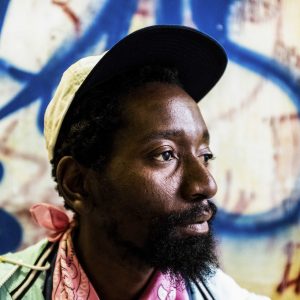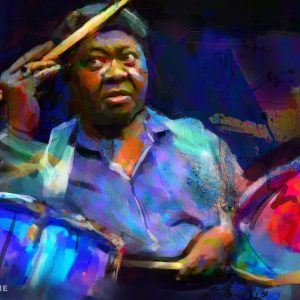Life in jazz notes and rhythm
The Cosmology concert, rooted in the shared history of musical cosmopolitanism in Joburg and Accra, showed the power of jazz in bridging, speaking to and transcending all kinds of borders.
Author:
6 November 2020

“My encounter with [John] Coltrane was a political one. The 1970s was also an intense period in the African liberation struggles … A Love Supreme and John Coltrane became a healing force; a manifesto for the cultural revolution; the spiritual needs of African revolutionary struggles.” – Nii Noi Nortey, Anyaa Arts Quartet.
When you’re talking about jazz, “space” and “time” can have many meanings. There are physical spaces – the stage, the venue, the scene, the city – where musicians perform, and the spiritual and intellectual spaces their music draws from and talks to. There are beats to the bar (the time signature), the time patterns dancers’ feet and players’ notes make around them, and the time in history the music came from or talks to. Louis Armstrong wasn’t overstating when he said, “What we play is life.”
It was that power of jazz in bridging and transcending all kinds of spatiotemporal – and political – borders that inspired the Cosmology concert and mini-festival, an action research project presented by the Wits School of Arts in the final days of October.
Drawing on the work of Santa Fe-based music scholar and musician Steven Feld with the Ghana-based Anyaa Arts Quartet, the event was originally conceived last year as a live collaboration.
Johannesburg and Accra share a history of musical cosmopolitanism. Both were “places of gold” and because of that migrant workers, largely internal migrants to Accra but from across southern Africa to Joburg, shaped the cities’ urban music cultures. In both, popular early forms of jazzy dance music – highlife in Ghana and marabi in Joburg – emerged to form, assert and question identity against colonial oppression. And in both, new sounds remain part of that same discourse today, signifying elements from home music traditions and international sources, and sharing those sonic innovations with whomever, from wherever, has the ears for them.

Jazz cosmopolitanism
Nii Noi Nortey, the leader of the Accra quartet, played saxophone in London – he features on the Misty in Roots album, Earth – and studied mbira in Zimbabwe. When he returned to Ghana, he took the music of Coltrane – what the saxophonist offered to Africa, and the inspiration he had clearly drawn from it – as the spark for developing an innovative cultural praxis around sound, sculpture and building novel instruments that adapted and combined traditional and modern parts. These initiatives coalesced into the Anyaa Arts Library, founded in 1990 as a centre hosting music research, instrument manufacture, debate, performance and exhibition.
Propelled by Wits School of Arts head Brett Pyper and the festival study group he steers, the university planned to bring the quartet, including Feld, to Joburg to develop and present collaborative work in early 2020. The aim was to explore how, Pyper said, “jazz cosmopolitanism has manifested in southern Africa”. They didn’t expect the slamming shut, just at that moment, of Covid-19-related barriers to travel and live sociality.
So the event was rescheduled, reimagined in shape and form, and eventually retitled Cosmology in part-tribute to other jazz boundary-breakers, including sonic space traveller Sun Ra and Zim Ngqawana, and his album Zimology. Student videographers and other student backstage and front-of-house personnel contained the event in terms of public health and ensured that the project advanced skills development.
Related article:
The cosmopolitanism Feld found and documented in Accra has clear parallels all through South African jazz history. Listening to American jazz recordings, the late trumpeter Johnny Mekoa immediately identified that “this is our music … the rhythms are more like our mbaqanga”. When young German photographer Jürgen Schadeberg arrived for a job at Drum magazine in the 1950s, he found “Sophiatown was like a Mediterranean city … Sophiatown Africans were modern people”.
Feld first established common ground with Nortey when he said he was from Philadelphia, to which Nortey immediately responded, “The city of John Coltrane.” In the Eastern Cape, Winston “Mankunku” Ngozi recorded Yakhal’ Inkomo as a lament on the death of Coltrane and, simultaneously, a wordless protest for “the black man’s pain”. He asserted that sometimes he felt Coltrane as a spiritual presence at his shoulder when he played.
Nortey describes his time in London as one when many South African musicians “lit a torch” for their British and Caribbean co-players and “the background against which I formulated my music”. For everybody, such lived fractures in the boundaries of time, geography and corporeality were springboards for innovation, not imitation. Nortey sets his invented instruments, which he calls afrifons, in the context of “the need to constantly redivine the creative process”.
A homegrown counter-narrative
For South Africans under apartheid, boundaries were harsh and tangible: Pass Laws, restrictions on travel and gatherings, and forced removals, with state-sanctioned killing for those who overstepped. In townships such as Mamelodi, but many more, too, dispersed people reforged communal bonds through their own, often overlapping political, social and cultural organisations, including the Jazz Appreciation Societies. LPs from home and abroad inspired a broader culture, including mutual assistance, stylish dress and a unique dance style that participated in music-making and provided commentary on it, known as diga or digger dance.
In tribute to this, poet and jazz appreciator Aubrey Motau opened the festival colloquium with a poem about his parents’ role in this scene: his mother “like a lion in the bush/ she is a collector of jazz/ and quality clothing”.
That still-flourishing, cosmopolitan, working-class jazz culture offers a powerful riposte to what Pyper describes as today’s “rather corporate, masculinist face [of jazz] that tends to be canonised and publicly presented”. The Cosmology concert, played live and streamed from the Wits Theatre to destinations including Accra, Santa Fe and Mamelodi, demonstrated the power of South Africa’s homegrown counter-narrative. The concert was linked with the Mamelodi Arts and Culture Forum, which works to keep community cultural life strong and honour veterans such as 82-year-old Malombo founder Abbey Cindi, who still performs today.
Related article:
The playlist was shaped by musical director, composer, bassist and teacher Chantal Willie-Petersen. As well as works by Coltrane, Giant Steps co-arranged with Kgomotso Moshugi, it featured work from trumpeter Feya Faku and concert guests, saxophonist Salim Washington and trumpeter Prince Lengoasa. She selected compositions, she says, “by female jazz composers who’ve been influenced by the music of John Coltrane: Alice Coltrane, Miriam Makeba, Zap Mama, Sathima Benjamin.
“With Alice Coltrane’s Blue Nile, for example, a minor blues with a repetitive melodic line similar to Coltrane’s Equinox, I’ve tried to reproduce the sounds of Alice’s harp by writing and arranging the voice parts in a polyphonic structure that incorporates the sounds of groups such as Zap Mama, and the African vocal techniques of yodel sounds and reed-like voice production.”
Willie-Petersen’s piece, Build Dreams – For My Sissie, took rhythmic inspiration from highlife music. Benjamin’s song Music was underpinned by goema beats to invoke the cosmopolitanism of the Cape. She points out that women are ubiquitous in jazz, working “as lyricists, teachers, performers, promoters, administrators, publicists, journalists, scholars…” This was underlined by broadcaster Brenda Sisane’s radio preview of the concert, which interviewed jazz collectors Julia Ngwenya and Jennifer Mahlangu, and by the festival’s diga dance workshop the previous day, steered by Thabo Rapoo, where Mahlangu made important contributions.
Calls embodied in choreography
At the concert, a succession of stylishly clad diga dancers – younger and older, men and women – sashayed on to the Wits Theatre stage as the spirit took them, to dance their commentaries on the sounds. Their solos drew from traditional moves, contemporary jazz and tap footwork, and inspired personal choreography, joyfully disregarding boundaries of genre, gender and music “professionalism”. A bright jacket was caped into wings. Jewelled light bounced off mirror-shined shoes. Invisible specks of dust were flicked from an immaculate tartan trouser leg. Scarlet block-heeled pumps traced the flutter of Prince Lengoasa’s trumpet notes. Responding to these embodied calls, the players aimed higher, faster and further out. Lengoasa, usually a stage presence of some gravitas, even put his horn down to shake a very creditable leg.
In the 1950s, a young British sax player touring South Africa, Johnny Dankworth, was surprised by an erudite backstage conversation about his music at the Wits Great Hall with an older man in a brown duster coat, whom he assumed was a maintenance worker. It was pianist Sol Klaaste, one of the top jazzmen of his day, but “this is the only way a Black man like me can get in to see you tonight”.
Those racist rules are gone, but city-centre theatres are still often inaccessible or unwelcoming for township communities, even to sit passively in the stalls, let alone proactively walk on stage and dance. Cosmology demonstrated different possibilities, where sophisticated internationalism does not bow to the cultural steamroller of global capital. The festival showcased a distinctively South African people’s jazz culture that really does have diamonds on the soles of its shoes.


